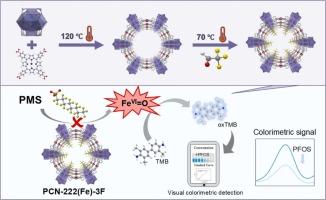Colorimetric sensing platform based on persulfate activation on fluorine-modified metal-organic frameworks for fast and selective detection of perfluorooctane sulfonic acid
IF 3.7
1区 化学
Q1 CHEMISTRY, ANALYTICAL
引用次数: 0
Abstract
Widespread environmental pollution by highly-persistent and toxic perfluorooctane sulfonic acid (PFOS) underscores the need for a low-cost, high-throughput detection method to assess exposure risks and regulatory compliance. Herein, we developed a novel colorimetric sensing platform, based on peroxymonosulfate (PMS) activation by fluorine-modified metal-organic frameworks (MOFs), for sensitive and selective PFOS detection. Specifically, PCN-222(Fe) and its fluorinated counterpart, PCN-222(Fe)-3F, efficiently activate PMS, leading to the oxidation of the chromogenic substrate 3,3’,5,5’-tetramethylbenzidine (TMB) into its blue oxidized form. The oxidation is primarily mediated by high-valent iron-oxo species rather than free radicals, offering high selectivity. PFOS binds to the catalytic sites of MOFs, effectively inhibiting TMB oxidation. PCN-222(Fe)-3F exhibits superior PFOS selectivity compared to PCN-222(Fe) owing to specific fluorine-fluorine interactions. The developed colorimetric sensor has a low detection limit of 12.6 nM, fast detection within 30 min, and a broad linear range. It exhibits excellent selectivity against common interferents and performs reliably in real water sample analysis. The reported colorimetric sensor based on persulfate activation offers a promising approach for the development of low-cost, high-throughput, and on-site screening of per-and perfluorinated alkyl substances.

基于过硫酸盐活化氟修饰金属-有机骨架的比色传感平台快速选择性检测全氟辛烷磺酸
高持久性和毒性全氟辛烷磺酸造成的广泛环境污染突出表明,需要一种低成本、高通量的检测方法来评估接触风险和法规遵守情况。在此,我们开发了一种新的比色传感平台,基于氟修饰金属有机框架(MOFs)的过氧单硫酸盐(PMS)活化,用于灵敏和选择性的全氟辛烷磺酸检测。具体来说,PCN-222(Fe)及其氟化对应物PCN-222(Fe)-3F有效地激活PMS,导致显色底物3,3 ',5,5 ' -四甲基联苯胺(TMB)氧化成蓝色氧化形式。氧化主要是由高价氧化铁而不是自由基介导的,具有很高的选择性。PFOS与mof的催化位点结合,有效抑制TMB氧化。由于特定的氟-氟相互作用,PCN-222(Fe)-3F比PCN-222(Fe)表现出更好的全氟辛烷磺酸选择性。该比色传感器检测限低,为12.6 nM, 30分钟内检测速度快,线性范围宽。它对常见的干扰具有良好的选择性,在实际水样分析中表现可靠。报道的基于过硫酸盐活化的比色传感器为开发低成本、高通量和现场筛选全氟和全氟烷基物质提供了一种有前途的方法。
本文章由计算机程序翻译,如有差异,请以英文原文为准。
求助全文
约1分钟内获得全文
求助全文
来源期刊

Sensors and Actuators B: Chemical
工程技术-电化学
CiteScore
14.60
自引率
11.90%
发文量
1776
审稿时长
3.2 months
期刊介绍:
Sensors & Actuators, B: Chemical is an international journal focused on the research and development of chemical transducers. It covers chemical sensors and biosensors, chemical actuators, and analytical microsystems. The journal is interdisciplinary, aiming to publish original works showcasing substantial advancements beyond the current state of the art in these fields, with practical applicability to solving meaningful analytical problems. Review articles are accepted by invitation from an Editor of the journal.
 求助内容:
求助内容: 应助结果提醒方式:
应助结果提醒方式:


